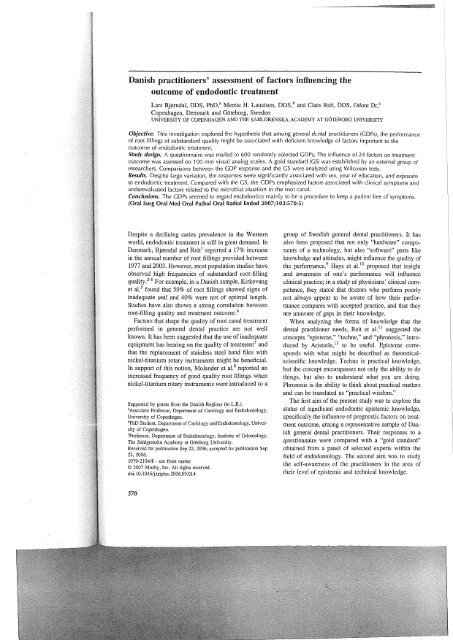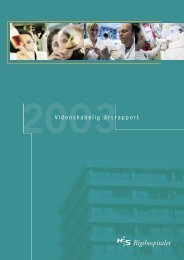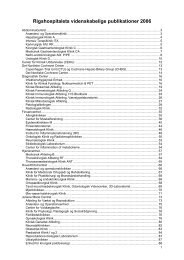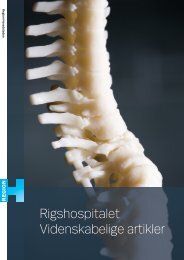View - CTU
View - CTU
View - CTU
Create successful ePaper yourself
Turn your PDF publications into a flip-book with our unique Google optimized e-Paper software.
Danish practitioners' assessment of factors influencing the<br />
outcome of endodontic treatment<br />
Lars Bj¢rndal, DDS, PhD," Merete H. Laustsen, DDS,b and Claes Reit, DDS, Odont Dr,c<br />
Copenhagen, Denmark and Goteborg, Sweden<br />
UNIVERSITY OF COPENHAGEN AND THE SAHLGRENSKA ACADEMY AT GOTEBORG UNIVERSITY<br />
Objective. This investigation explored the hypothesis that among general drntal practitioners (GDPs), the performance<br />
of root fillings of substandard quality might be associated with deficient knowledge of factors important to the<br />
outcome of endodontic treatment.<br />
Study design. A questionnaire was mailed to 600 randomly selected GDPs. The influence of 24 factors on treatment<br />
outcome was assessed on 100 mm visual analog scales. A gold standard (GS) was established by an external group of<br />
researchers. Comparisons between the GDP response and the GS were analyzed using Wilcoxon tests.<br />
Results. Despite large variation, the responses were significantly associated with sex, year of education, and exposure<br />
to endodontic treatment. Compared with the GS, the GDPs emphasized factors associated with clinical symptoms and<br />
underevaluated factors related to the microbial situation in the root canal.<br />
Conclusions. The GDPs seemed to regard endodontics mainly to be a procedure to keep a patient free of symptoms.<br />
(Oral Surg Oral Med Oral Pathol Oral Radiol Endod 2007;103:570-5)<br />
Despite a declining caries prevalence in the Western<br />
world, endodontic treatment is still in great demand. In<br />
Denmark, Bj¢mdal and Reit 1 reported a 17% increase<br />
in the annual number of root fillings provided between<br />
1977 and 2003. However, most population studies have<br />
observed high frequencies of substandard root-filling<br />
quality. 2 - 5 For example, in a Danish sample, Kirkevang<br />
et al. 5 found that 59% of root fillings showed signs of<br />
inadequate seal and 40% were not of optimal length.<br />
Studies have also shown a strong correlation between<br />
root-filling quality and treatment outcome. 6<br />
Factors that shape the quality of root canal treatment<br />
performed in general dental practice are not well<br />
known. It has been suggested that the use of inadequate<br />
equipment has bearing on the quality of treatment7 and<br />
that the replacement of stainless steel hand files with<br />
nickel-titanium rotary instruments might be beneficial.<br />
In support of this notion, Molander et al. 8 reported an<br />
increased frequency of good quality root fillings when<br />
nickel-titanium rotary instruments were introduced to a<br />
Supported by grants from the Danish Regions (to L.B.).<br />
•Associate Professor, Department of Cariology and Endodontology,<br />
University of Copenhagen.<br />
bphD Student, Department of Cariology and Endodontology, University<br />
of Copenhagen.<br />
'Professor, Department of Endodontology, Institute of Odontology,<br />
The Sahlgrenska Academy at Goteborg University.<br />
Received for publication Sep 22, 2006; accepted for publication Sep<br />
22, 2006.<br />
1079-2104/$ - see front matter<br />
© 2007 Mosby, Inc. All rights reserved.<br />
doi: 10.1016/j. tripleo.2006.09.014<br />
group of Swedish general dental practitioners. It has<br />
also been proposed that not only "hardware" components<br />
of a technology, but also "software" parts like<br />
knowledge and attitudes, might influence the quality of<br />
the performance. 9 Hays et aI. 10 proposed that insight<br />
and awareness of one's performance will influence<br />
clinical practice; in a study of physicians' clinical competence,<br />
they stated that doctors who perform poorly<br />
not always appear to be aware of how their performance<br />
compares with accepted practice, and that they<br />
are unaware of gaps in their knowledge.<br />
When analyzing the forms of knowledge that the<br />
dental practitioner needs, Reit et al. 11 suggested the<br />
concepts "episteme," "techne," and "phronesis," introduced<br />
by Aristotle, 12 to be useful. Episteme corresponds<br />
with what might be described as theoreticalscientific<br />
knowledge. Techne is practical knowledge,<br />
but the concept encompasses not only the ability to do<br />
things, but also to understand what you are doing.<br />
Phronesis is the ability to think about practical matters<br />
and can be translated as "practical wisdom."<br />
The first aim of the present study was to explore the<br />
status of significant endodontic epistemic knowledge,<br />
specifically the influence of prognostic factors on treatment<br />
outcome, among a representative sample of Danish<br />
general dental practitioners. Their responses to a<br />
questionnaire were compared with a "gold standard"<br />
obtained from a panel of selected experts within the<br />
field of endodontology. The second aim was to study<br />
the self-awareness of the practitioners in the area of<br />
their level of epistemic and technical knowledge.<br />
570








